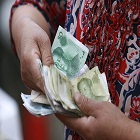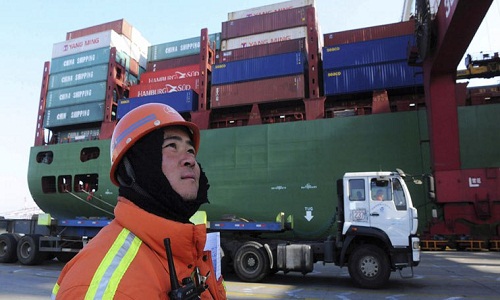FW
Trident for the March quarter has reported a net profit of Rs 55.48 crores. Net profits have seen a surge of 37 per cent as compared to the fourth quarter of financial year ’15. EBITDA for the period stands at Rs 194.22 crores. Total income from operations stands at Rs 968 crores for the quarter as against Rs 978 crores for the corresponding period of the previous fiscal.
On a year on year basis, net profits after minority interest stand at Rs 227.98 crores whereas for the previous fiscal it stood at Rs 117.81 crores. Net profit has increased by 93 per cent. EBITDA stands at Rs 741.41 crores and has increased by seven per cent from the previous year. Consolidated total income for the period stands at Rs 3706.49 crores.
On a CAGR basis, EBITDA and net profits for the period of three years have grown by four per cent and 39 per cent respectively.
Trident is an Indian company engaged in the business of manufacturing agro based paper, yarn, terry towels and sulphuric acid. The company also has a captive power plant. The company operates in two business segments: textile and paper. The company is currently in an expansion phase but has managed to post double digit profits.
Several sportswear companies are looking to participate in the active wear boom through the inorganic route. In May 2014, Columbia Sportswear acquired 100 per cent ownership of prAna. prAna is a yoga wear lifestyle brand that’s seeing not only strong sales traction, albeit on a smaller scale, but also diversification benefits for the remainder of Columbia’s product portfolio.
Hanesbrands has made two acquisitions in the active wear space. In 2010, the company acquired Gearco, which owned the Gear for Sports brand. In 2015, the company purchased Knights Apparel. The products of both companies use licensed collegiate logo apparel.
Some companies have also looked at providing brand exclusives with select retailers. Hanesbrands’ C9 by Champion products retail exclusively in Target stores. Target and Walmart accounted for about 28 per cent and 21 per cent of Hanesbrands’ US active wear sales, respectively, in 2015.
While Kohl’s has reported strong sales in Nike products, the company has also launched its own line in partnership with Shay Mitchell. Companies such as Nike are looking to expand distribution through wholesalers, including department stores such as Macy’s and Kohl’s, both within and outside the United States. Nike’s largest wholesale partner, Foot Locker, is also looking to expand on vendor relationships to drive higher apparel sales, particularly among women and children.
Pakistan and Romania are interested in strengthening bilateral trade relations.Around 700 Pakistani investors are looking at profitable business ventures in Romania.
Presently, Romania imports cotton, leather, garments, fruits and bed sheets from Pakistan; while Pakistan imports white timber, wood furniture, chemicals, cereals, flowers, canola seeds.
Pakistani products like textile, leather, and mangoes are very popular in Romania. Romania is a member state of the European Union.
Historical relations between Pakistan and Romania were established in 1964. Both countries are exploring more avenues of cooperation in diversified fields. Organising joint cultural shows and frequent exchange of business delegations are the options which could be used to exploit untapped bilateral trade and investment potential in both countries. The countries are looking to promote and consolidate bilateral cooperation in the political, economic, trade and cultural areas.
The trade volume between Pakistan and Romania is 300 million dollars a year. Pakistani products are very popular in Romania. Pakistan is interested in exporting its products, especially textiles, garments, leather articles, sports goods, pharmaceutical products, rice and surgical instruments, to Romania.
Romania is the only country which has four honorary consulates in Pakistan. The Pakistan-Romania Friendship Association is wholeheartedly working to cement relations and explore more areas to work on.
Malaysian designers are looking to penetrate the Chinese market amid a growing demand for more fashion labels. Recently two leading Malaysian fashion designers, Khoon Hooi and Melinda Looi, presented their autumn/winter 2016 collections at the Shanghai Fashion Week.
Spending power in China is expected to grow in tandem with its rising economy, especially from the growing middle class. Shanghai is poised to be at the forefront of China’s fashion industry. Malaysian designers oriented towards sophisticated, modern and chic designs are considering Shanghai as their base in China.
The total import value of garments and shoes by China reached 6.6 billion dollars last year, an increase of 6.4 per cent as compared to the previous year.
The expansion of China’s middle class in recent years has also resulted in a positive growth in demand for imported clothing.
In Melinda Looi’s second season in China, she felt encouraged by the positive response from buyers and the media. Looi’s collections are sold in over ten countries and she expects the Chinese market to become the key market for her within the next one to two years.
In the past, she and Khoon Hooi have trotted out their collections at trade shows and fashion events in fashion cities such as Paris, London, Milan and New York.

Rubal Jain, Managing Director, Safexpress, has been named by the Economic Times as the most inspiring business leader in logistics.
He has completed his MBA from Stanford University, US. He has also completed his bachelor degree in Operations Research from Columbia University, US.
Jain strongly focuses on building successful relationships with customers by ensuring best-in-class service and quality levels. He has spearheaded the development and rollout of an Oracle based ERP system for IT-enabled processes in operations and finance at Safexpress.
Safexpress considered a synonymous with supply chain and logistics in India, the brand plans to continue expanding its network further. It has planned a few more logistics parks this year, at locations like Varanasi, Siliguri, Jaipur and Aurangabad. It is also investing heavily in technology.
Safexpress which opened in 1997 offers cutting edge logistics solutions to its customers, enabling them to focus on their core competencies. The firm adds maximum value to businesses at every level, right from providing world-class warehousing support to ensuring time-definite deliveries of goods.
With its fleet of over 4500 GPS-enabled vehicles and the country’s largest distribution network spanning over 610 destinations, Safexpress covers every corner of India. Safexpress provides supply chain and logistics services to over 5000 corporate clients.
"China is continuing to expand its share in global exports market, while its product mix is becoming increasingly sophisticated and high-tech. Last year, China recorded its first decline in export value since the financial crisis of 2009. This has triggered concerns as to whether China’s export competitiveness is eroding rapidly in light of the competition arising from the emerging number of alternative production bases."

China is continuing to expand its share in global exports market, while its product mix is becoming increasingly sophisticated and high-tech. Last year, China recorded its first decline in export value since the financial crisis of 2009. This has triggered concerns as to whether China’s export competitiveness is eroding rapidly in light of the competition arising from the emerging number of alternative production bases. There is a clear indication that labour-intensive production in certain sectors is relocating away from China, with South or South-east Asia being the likely beneficiary. Despite this, trade statistics show that China is continuing to expand its share of the overall world export market share, while its export product mix is becoming increasingly sophisticated and high-tech.
Expanding world export share

Recently released WTO’s global trade figures show, total export values across the world dropped by 13.2 per cent in 2015, falling to $16.5 trillion. Although China’s total exports dropped by 2.9 per cent in 2015, it had the smallest decline of all the major exporters. Aside from Vietnam, China’s exports were also declining at a slower pace than any of the alternative production bases in Asia. As a result, China’s global market share of merchandise exports continued to increase, rising from 12.3 per cent in 2014 to 13.8 per cent in 2015.
This could distort the overall picture, as merchandise exports include agricultural products, fuel and mining products. If, however, consider only those exports directly affected by production costs, WTO statistics show that China’s share of global manufacturing exports has also continued to increase over recent years, rising from 14.8 per cent in 2010 to 18 per cent in 2014.
Overall import share
With regard to both the US and the EU, China’s share of their imports also increased during this period. As per US statistics, China’s share of US imports rose from 18.1 per cent in 2011 to 21.5 per cent in 2015. When oil imports are excluded, China’s share increased from 22.8 per cent to 23.7 per cent for the same period. In the case of the EU, statistics show China share of extra-EU imports increased from 17.1 per cent in 2011 to 20.3 per cent in 2015.
In a number of the emerging markets in Asia and Latin America, China is also gaining import market share. According to ASEAN statistics, for instance, imports from China accounted for 12.8 per cent of the Association’s total imports in 2011, increasing to 17.5 per cent in 2014. A similar pattern is evident in the statistics relating to individual countries. China’s share of Malaysia’s non-oil imports, for instance, jumped from 14.7 per cent in 2011 to 20.8 per cent in 2015. Over the same period, its share of Thailand’s non-oil imports increased from 15.8 per cent to 22.8 per cent. In the case of Mexico, China-sourced imports increased from 14.9 per cent in 2011 to 17.7 per cent in 2015, while in Brazil the figure rose from 14.5 per cent to 17.9 per cent.
Export competitiveness
While China’s exports remain competitive, as reflected in the country’s market share of global exports, the relocation of manufacturing from China to other production bases, particularly to those in other parts of Asia, has inevitably affected its overall share of exports of labour intensive or lower value-added products. In the case of garments, China’s share in terms of US imports dropped slightly, falling from 39.4 per cent in 2011 to 37.4 per cent in 2015.
In footwear, while China still commands the lion’s share of US imports, its percentage share dropped from 73.9 per cent in 2011 to 62.5 per cent in 2015. In the case of extra-EU imports of footwear, China’s share declined from 50.5 per cent in 2011 to 46.3 per cent in 2015. With regard to both US and extra-EU imports of footwear, Vietnam and Indonesia have emerged as the major alternative suppliers. Garments and footwear aside, China’s share in other sectors, such as toys, remained more or less unchanged.
Gaining share in electronics and semi-manufactures China has been diversifying its exports away from traditional, labour-intensive, lower-end products to more advanced, high-tech items, including both final consumer products and upstream semi-manufactures over the years. According to WTO statistics, China’ global share of telecommunications exports, for example, increased from 29.4 per cent in 2009 to 39.5 per cent in 2014, while its share of textiles increased from 28.3 per cent to 35.6 per cent.
In household electrical appliances, China’s US import share has generally demonstrated an upward trend, increasing from 39.2 per cent in 2011 to 42.4 per cent in 2015. With regard to extra-EU imports in the same sector, China’s share again increased, rising from 47.4 per cent to 52.1 per cent over the same period.
It is likely that the relocation of final assembly works to alternative low-cost production bases in Asia may have contributed to China’s growing export of raw materials and semi-manufactures destined for further processing. Based on China’s own statistics, a rough estimation shows that the country’s export of raw materials and semi-manufactures recorded an average annual compound growth of 9.1 per cent between 2010 and 2015.
In particular, China’s exports of textiles to Vietnam, the alternative production base for garments is most noticeably. It gained share in overseas markets, and grew by an average annual compound growth of 22.6 per cent between 2010 and 2015. At the same time, textile exports to Bangladesh showed an average annual growth of 13.2 per cent.
Labour productivity and clustering effects
According to the Asian Productivity Organisation, China’s average level of labour productivity grew by 9.3 per cent per annum between 2005 to 2013, far higher than was the case in a number of alternative production bases in Asia – notably Vietnam (3.7 per cent), Indonesia (3.4 per cent) and Bangladesh (2.8 per cent).
Manufacturers in China also benefit from their access to well-developed industrial clusters, with upstream supplies easily sourced locally as well as the skills of its domestic labour force. With ample supply of both services and upstream and downstream products, manufacturers are assured of the provision of a strong supply chain, ensuring ready access to ancillary industries, products and spare parts. China’s competitive advantage in the more advanced industries will only become more pronounced as the country continues to invest in R&D and move up the production value chain.
Arvind, one of India’s largest integrated textile manufacture has, posted a 14 per cent increase in its net profit to Rs 110 crores in the quarter ending March 2016 as against Rs 97 crores in the same quarter a year ago. The brand’s business continued to remain strong with 30 per cent CAGR in Q4.
Arvind ended the fiscal 2015-16 with revenues of Rs 8,431.45 crores up 7.89 per cent and net profits of Rs 362.70 crores, up 6.33 per cent. Operating profits of the company were up 13.13 per cent at Rs 230.28 crore for the quarter ending March 2016 against Rs 203.55 crore the previous year. The operating profit margins for the quarter were recorded at 9.97 per cent, down 0.05 per cent against 9.97 per cent a year ago. Operating profits for the year were at Rs 809.20 crores, up 1.08 per cent. Consolidated earnings before interest, taxes, depreciation, and amortisation (EBITDA) is up by 14 per cent at Rs 297 crores, compared to Rs 260 crores in the corresponding quarter of the previous year.
The company will soon be launching NNNow.com, a shopping platform for Indian customers which will link the offline and online retail shopping experience.
Lenzing is a leading manufacturer of man-made cellulosic fibers has seen substantial increase in earnings in the first quarter of 2016, achieving the best first quarter results since the financial year 2012. Net profit for the period increased almost threefold. Lenzing also achieved close to a three-fold improvement in its cash flow position.
Consolidated revenue rose by 8.1 per cent in the first quarter of 2016 compared to the first quarter of 2015. This increase is mainly attributable to the strong demand for Lenzing fibers and higher fiber selling prices. Consolidated earnings before interest, tax, depreciation and amortization (EBITDA) rose by 54.7 per cent. This corresponds to an EBITDA margin of 18 per cent, up from 12.6 per cent in the previous year. Earnings before interest and tax (EBIT) more than doubled. Accordingly, the EBIT margin climbed to 11.6 per cent from the 5.7 per cent of the prior-year quarter.
Assuming that the overall business environment remains unchanged, Lenzing continues to expect a substantial improvement in earnings for the financial year 2016. It plans to expand its production capacities for specialty fibers. Various existing and new sites around the world are currently being examined to add new capacities.
This June marks the 90th edition of Pitti Immagine Uomo - an important moment in the journey of this event, which over the years, has become the reference trade fair showcasing men’s fashion and the latest trends in contemporary style on a global level. The first edition of Pitti Uomo was held in February 1972 at Florence. There were 43 exhibiting companies and a total of 526 buyers attended, 98 of which came from abroad.
At Pitti Uomo 90 to be held at the Fortezza da Basso, which has long been the fair’s hub, there will be over 1200 collections in total and more than 20,000 buyers are expected, 8,200 of which from abroad. These numbers attest to the evolution of the fair and of a world that is growing and developing every season, focusing on quality, research and internationality. It also proves the fair’s ability– at each edition – to generate new ideas and surprise its increasingly global public.
Pitti Immagine’s partnership with talented video makers has continued with the creation of digital art for the show’s advertising campaign. This new project applies motion design to the Pitti Lucky Numbers theme under the creative hand of Sergio Pappalettera and the direction of Ced Pakusevskij, with photography by Toni Thorimbert, production by HI Production and Max Brun’s supervision.
World Textile Information Network (WTiN) and IMI Europe have signed a strategic partnership for co-operation in the delivery of events and intelligence for the inkjet technology and textile user community. As per the deal, WTiN will offer its unrivalled knowledge of the digital textile printing market to further strengthen the technical content of IMI Europe conferences and seminars, while IMI Europe will in turn supply insights for WTiN media and events into new developments in the broader inkjet field, helping to analyse their potential impact on textile applications. The agreement also opens the way for joint activities in future.
WTiN is the publisher of the world-leading Digital Textile magazine and unique WTiN Intelligence: Digital Textilesservice, delivering detailed market data based on primary sources. It also has an ongoing global programme of WTiN Digital Textile Conferences, of which the next will be in New York on July 13, co-located with the Texworld USA fabric exhibition.
IMI Europe is the recognised leader in the delivery of high-level strategic and technical events for the inkjet printing industry, developing and organising high quality conferences and courses in Europe and Asia. Its annual events include the IMI Europe Inkjet Summer School (Heidelberg, Germany, June 20-24) and the IMI Europe Digital Printing Conference (Amsterdam, Netherlands, November 28-December 1).












